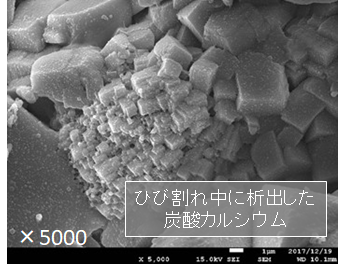Self-healing to extend the life of infrastructure
※The content is current at the time of writing.
Microorganisms heal cracks in concrete.
Research Overview

Concrete structures that make up the social infrastructure that supports our daily lives are unable to fulfill their functions due to cracks and rusting steel. It would be good if we could repair deterioration and damage as soon as it is detected, but it is difficult to detect damage that occurs inside infrastructure structures, and even if repairs can be made, they are usually carried out symptomatically after deterioration has progressed considerably. Against this social background, we are researching self-healing technologies to minimize the damage and deterioration of infrastructure structures, restore their performance promptly, and extend their service life.
Research Features
We are developing a new technology that not only heals cracks in concrete, but also suppresses corrosion of reinforcing steel “on its own”. Steel corrosion is a phenomenon in which steel dissolves while consuming oxygen and water. Such electrochemical reactions cannot proceed if the necessary substances are not present. In other words, the less oxygen there is in the concrete, the slower the corrosion reaction of the rebar will be. In the field of materials science for social infrastructure, we are focusing on this phenomenon and conducting research from the search for materials that can reduce the oxygen inside concrete.


Research Attraction
In recent years, we have been focusing on aerobic microorganisms, which breathe inside concrete, consuming oxygen and emitting carbon dioxide to plug cracks caused by calcium carbonate. Among them, Bacillus subtilis natto was found to have biological metabolism (respiration) even in highly alkaline environments, and I am researching its utilization. The research field of social infrastructure is wide-ranging, and I think one of the attractions of university research is the opportunity to collaborate with colleagues in different fields of expertise to create new value through free thinking and ingenuity on fusion research issues such as civil engineering, materials, microorganisms, and sensing technology.
Future Outlook
We would like to utilize the results of our research to date to further deepen the elemental technologies required for practical application, and to work toward social demonstration and implementation. In particular, issues such as whether microorganisms can operate as expected in infrastructure structures constructed in various environments and how long their repair effects will last need to be verified through long-term exposure tests. It is also essential to develop sensing technologies to detect them. In the near future, we plan to verify the effectiveness of this technology by conducting test construction on actual structures, and we hope that this will lead to a step-up in social implementation.
Message to those who are interested in this research
The research field of social infrastructure is wide-ranging, and is characterized by a large number of research projects that integrate various engineering fields. Why don’t you extend the service life of the social infrastructure that has been accumulated so far and realize your ideas in the smart social infrastructure of the future that will be developed in the future?

